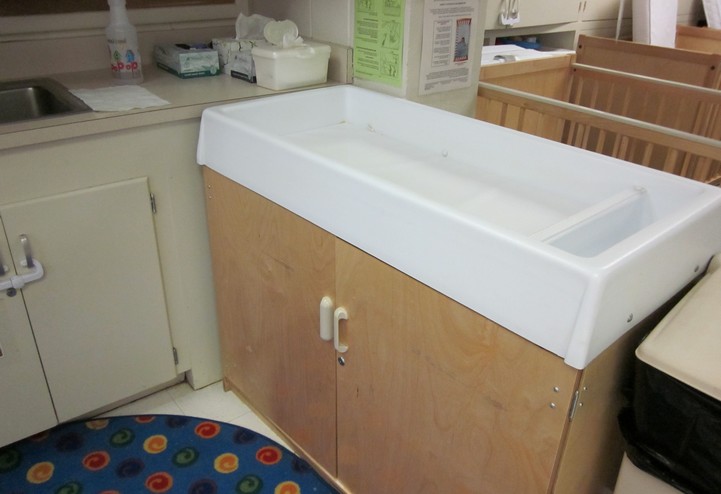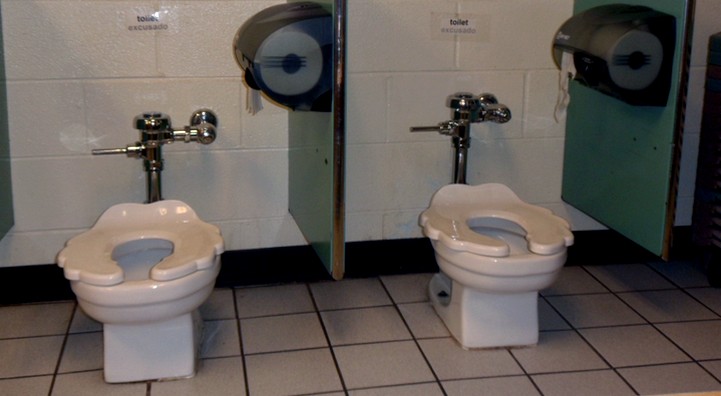Diapering, toileting, and hand washing are important routines in child care, and those areas of the child care classroom are important parts of children’s experience in child care. With thoughtful planning, child care providers can set up an area to handle these important caregiving routines while also significantly reducing the spread of germs and disease.
The Diapering Area
Diapering is a regular, everyday occurrence in infant and toddler classrooms. It is important to set up a diapering area that is safe and comfortable for young children and that also reduces the risk of spreading germs. The diapering area in a child care program should be:
- Located where the child care provider can see other children while changing a diaper.
- Very close to a hand washing sink.
- Separate from food preparation areas.
- Set up with space to store supplies near, but not on, the diapering surface.
- Protected with a raised edge to prevent children from falling.
- Covered in a non-porous surface that can be cleaned and sanitized easily.
A properly arranged diapering area helps reduce the spread of germs and makes the child feel safe and comfortable at the same time. For more information and tips, see Tips to Prevent Spreading Germs during Diapering and 10 Steps to Change a Diaper in a Child Care Setting.
The Toileting Area
Learning to use the toilet is an important self-care routine for young children. The toileting area is an important part of the classroom, especially when children are going through the toilet learning process. There are several different options for toilet areas in a child care setting. All can be equally successful if used and cleaned properly. The options include the following:
- Open Toilets in the Classroom. In some child care centers, two to four toilets, without stalls, are integrated into the classroom environment for toddlers and preschoolers. In this open setting, children can learn how to use the toilet by observing each other because toileting is a normal part of the daily routine. It is also easy for child care providers to monitor all children if the space is open.
- Toilet Stalls in the Classroom. Some child care centers have toilets in the classroom, but the toilets are divided into stalls, with or without doors. Having stalls provides more privacy for older preschoolers and school-age children. Having the toilets in the classroom simplifies supervision because a child care provider does not have to leave the room when a child needs to use the toilet.
- Separate Bathrooms. In some child care centers, toilets are in a bathroom with a door. Bathrooms may have one or several toilets, with or without stalls. When the bathroom is separate, a child care provider must accompany children to the bathroom.
No matter which type of toilet area is part of your classroom, child care providers play important roles as young children learn to use the toilet. Child care providers should encourage children to use the toilet as independently as they are ready to, help with toileting as needed, and supervise children to ensure that they are following the rules. Bathrooms have many potential safety hazards, and children are at risk of injury if not properly supervised in the bathroom. For more information, check out the article on Bathroom Safety in Child Care.
Learning to use the toilet is an important developmental task for toddlers and young preschoolers. Child care providers can support toilet learning by watching for signs of readiness, planning the toilet learning process with parents, and helping children practice this important skill. For more information on toilet learning, see Helping Children with Toilet Learning in Child Care and Signs of Toilet Learning Readiness in Child Care.
The Hand Washing Area
Washing your hands is one of the easiest and best ways to prevent the spread of germs and disease. An effective, easy-to-use hand washing area can make hand washing simpler. Here are some issues to consider when planning the hand washing area in a child care setting:
- Sink location. Hand washing sinks should be located in areas where they are most useful for both adults and children. If you are planning a child care space, locate sinks near the toilet and diapering areas to encourage prompt, proper hand washing. Remember that hand washing sinks must be separate from sinks used for washing foods or other food preparation tasks.
- Child-sized hand washing sinks. Providing sinks that are low to the ground makes it easier for young children to practice independent hand washing, with appropriate adult supervision. When children can easily reach the sink and turn on the faucets independently, they feel a sense of accomplishment and are more likely to engage in voluntary hand washing.
- Automatic faucets. Adding motion-sensitive automatic faucets can cut down on the spread of germs because children do not have to touch the faucet to turn the water on and off. Automatic faucets can also prevent children from wasting water while washing their hands because the faucets turn on only when hands are placed in front of the sensor.
- Stools. If low hand washing sinks are not available, place a sturdy, stable stool at the sink area so children can easily reach the sink. Select stools with a handle if possible to reduce the chance of falls. Be sure to supervise children when they are using stools to reach the sink.
- Paper towel dispensers. Disposable single-use paper towels are an essential tool for hand washing. Mounting the towel dispenser low to the ground, just like the sinks, will enable children to practice self-help skills by getting their own towels. If possible, choose dispensers that dispense only one paper towel at a time to prevent waste and overuse. If very young children will be using the dispenser, avoid complicated levers or knobs.
- Liquid soap dispenser. Just like the towel dispenser, it is a good idea to have an automatic soap dispenser to cut down on waste. It is also important to have liquid soap available, even without the automatic dispenser. Bars of soap hold germs and are thus are not as effective as liquid soap in reducing the spread of germs. Hand sanitizers are not a substitute for washing hands with soap and water.
For tips on how to appropriately wash your hands while modeling proper hand washing for children, check out the following articles:
- Simple Steps for Thorough Hand Washing in Child Care
- Hand Washing Tips for Child Care Providers
- Using Hand Washing Songs to Encourage Children in Child Care to Wash Hands Thoroughly
Photo by Diane Bales / CC BY http://creativecommons.org/licenses/by/2.0/
Photo by Diane Bales / CC BY http://creativecommons.org/licenses/by/2.0/
Photo by Diane Bales / CC BY http://creativecommons.org/licenses/by/2.0/



